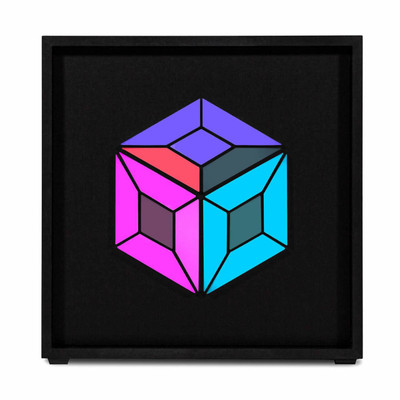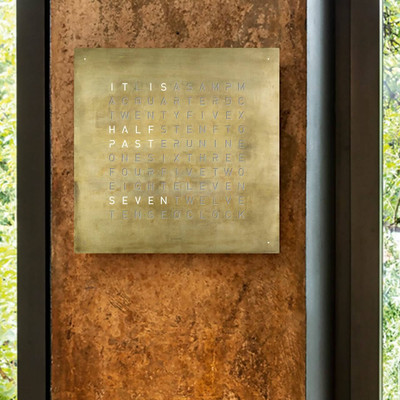-
About This Work
A mystery of ethereal shifting colors in a very unusual case. Every mid-century modern home needs its time measured by Aurora, not Alexa. The first thing you notice when encountering Aurora is the familiar yet foreign highly polished aluminum sculptural form and the colorfully illuminated clock face. You'll then notice that the clock face and overlapping secondhand disk continuously change colors as time passes. Finally, there are color shifts that occur relative to your movement around the clock. Even once you become familiar with the color shifts (though like us, maybe never the science), the color combinations continue to delight and surprise. Born in 1970, the Aurora has been redesigned and improved over the past 49 years. Since its origin, the Aurora has remained an ingenious balance of technology and design, and is cherished by old and new fans—including the permanent collection of The Museum of Modern Art.
THE CASE
The uniquely sculpted case is highly polished aluminum, cut out on a lathe and hand polished. Improving the original, this version has a more substantial base of 1/4 inch thick acrylic with a routed flame polished edge and rubber feet giving the clock a more finished appearance and sturdier base that won't scratch its resting surface.THE CLOCK
The biggest improvement in later models is the light source. The current Super Flux variable spectrum LED has a cooler running temperature, broader and more saturated color gamut, and the option to adjust the brightness. Also, the color changes more frequently (every 17 seconds vs 30 seconds) and less predictably than earlier models. 80% of the color changing is still from the rare birefringent filters; the LEDs add the remaining 20% effect. Without the filters, the hour & minute hands and second hand disk would all be the same color for each transition. The LEDs enhance (not replace) the polarizer technology. The polarized light technology is still what makes the Auroras wildly unique. The strong, metal geared clock motor is by the Hansen Corporation—the same (now hundred year old) US company that made them in the 1970's. The motor has a life expectancy of around 20 years, while the LED lights generally become 30% dimmer in 15-20 years.EUROPEAN CUSTOMERS: We sell a 230 VAC, 50 HZ version for $840 USD (includes shipping; customer is responsible for any customs fees). Please select European model option when adding to cart.
HISTORY OF AURORA
In 1970, ex-NASA physicist Jordan Kirsch and architect Jim Hamilton (who worked on the McDonnell Douglas DC-10 cabin around this time) patented the concept for a clock that used birefringent materials in a polarized light field. The result was a clock called Spectrum manufactured by Rathcon (Around 5,000 made; Rathcon also manufactured the Orbita clock at this time). Unsatisfied with the manufacturing quality at Rathcon, Kirsch-Hamilton re-designed and re-named the clock the Kirsch-Hamilton Aurora and moved production to Newton Plastics (NPC) in Newton, MA. Approximately 40,500 of these were made. The Spectrum and original Aurora used an incandescent lamp that caused the clock to run very hot and shortened the life of the motor and filters. Other polarized light clocks called the PRISMA™ (also available for sale on our website) & SPECTRA™ were designed and marketed from 1970-1990. The marketing company Hampton-Haddon bought the rights to the Aurora in the late 1980s and had a version made in Japan that was imported and sold in the US until 1991.The 1980s Japanese version of the Auroras had the most beautiful case; the aluminum was bright dipped and then clear anodized so it kept its shine and was hard to scratch (however anodized aluminum can not be polished out if it does get scratched). Unfortunately, the Japanese clock motors had plastic gears that were easy to damage when setting the time and wore out much sooner than the metal geared motors made by Hansen that are in the current (and 1970s) clocks. The Japanese version made improvements using cool running, cold cathode fluorescent lamps, but made the error of putting these lamps too near the rear polarizer which damaged it and cause dark streaks on the rear filter; to make matters worse, the rear polarizer was glued in place making it impossible to replace. Like the Rathcon version, once the motor goes on this model, everything within the case must be replaced with the U.S. manufactured Aurora version parts.
In 1993, engineer and horologist Barry Gamble (ChronoArt) started manufacturing Luminas (a polarized light clock) and in 1994 began repairing Auroras and manufacturing new Aurora models. His first Auroras (around 1993-1996) were made of brass plated in nickel-chrome; 25% were plated in 24k gold (most beautiful, but also pricey). The increase in the price of brass pushed the case back to polished aluminum. Still today's sole manufacturer, ChronoArt's improved Auroras are the longest lasting, most sophisticated and pleasing Aurora light show yet and return to the original polished aluminum case design of the 1970s.
****
Sources:
James Kraus. "Jet Age Design: The Aurora Clock." Auto Universum, May 5, 2017, https://autouniversum.wordpress.com/2017/05/05/jet-age-design-the-aurora-clock.
Barry Gamble. Chrono-Art, http://www.chronoart.com, date accessed: April 2, 2019 -
Technical Specs
- AURORA CLASSIC II
- Handmade in Cotati, California USA
- Dimensions: 8h x 5w x 8d in (20.3 x 12.7 x 20.3 cm)
- Weight: 4 lbs (1.8 kg)
- Hansen Corporation metal geared clock motor
- Precision: ±2 seconds/month (if power is maintained)
- Power Supply: 120 VAC 60 HZ, 10 WATTS (European customers: contact us to order the 230 VAC, 50 HZ model)
- FUNCTIONS
- Adjust time
- LED dimmer control
- Color changes every 17 seconds
- Rotating quarter wave retarder (second hand disk)
- OPTICS
- Super Flux Variable Spectrum LED & microprocessor
- Red, Blue, Green and White LEDs (8 each)
- Birefringent filters
- LEDs will dim only by 30% in 15-20 years
- CASE
- Lathe-cut hand polished aluminum
- 1/4 inch thick acrylic base with routed flame polished edge
- Scratch-resistant rubber feet
-
Quick Help & Manual
-
Download manufacturer manual
- Aurora Classic II Manual (pdf)
-
Setting the time
- Gently push in on the bottom edge of the rear cover. The back is held in place with magnets and will drop off into your hand. We recommend using cotton gloves or a clean micro-fiber towel to avoid leaving fingerprints.
- You may turn the time setting knob in either direction to set the time.
- Replace the rear cover.
-
Adjusting display brightness
The Aurora has a push button switch (black post) inside the back that allows you to dim the brightness. You may want to dim it for a bedroom, or brighten it for an office. The brightness level will reset after any power outage.
- Gently push in on the bottom edge of the rear cover. The back is held in place with magnets and will drop off into your hand. We recommend using cotton gloves or a clean micro-fiber towel to avoid leaving fingerprints.
- Push in and hold down the black post switch to change brightness.
- Each push will dim the light in 5 steps. When it gets to minimum brightness on the next push it will jump to maximum brightness.
- Earlier models: Each time you push down the post, the bright-dim direction will reverse. If you wish to use the clock at very low brightness unplug the clock, wait 20 seconds, then hold in the button while plugging it in. This will smooth out color changing; then set the brightness. It’s a little tricky how fast it changes near minimum brightness, our apologies.
- Replace the rear cover.
-
Cleaning
Use a clean micro-fiber towel for light dusting. Clean the case with aluminum/magnesium hubcap polish and use a micro-fiber towel for the final rubdown. Caution: Don’t get this very abrasive cleaner on the acrylic face. Do not use ammonia-based glass cleaners on the acrylic glass. Lightly fogging up the acrylic face with your breath, and wiping it down with a clean micro-fiber towel will typically be enough.
-
Extending the LED lifespan
After 15-20 years, the LEDs will lose about 30% of their brightness. After 20 years, the clock motor will probably fail. The Aurora Classic II runs much cooler than the original and is the longest lasting model yet. Displaying your clock at a lower brightness level (but bright enough so that you enjoy it to its fullest) will help extend the LEDs life.
-
Avoiding moisture
Going on vacation? Leave the clock plugged in & use the button in the rear to dim the lights. The small warmth in the clock will help keep moisture out.
-
Return policy
We do not offer full refunds for Aurora purchases, unless your clock arrives damaged or is malfunctioning. We will accept a return within 30 days if the clock is returned in original, unused condition. Buyer pays return shipping plus 10% restocking fee.
-
Warranty & repairs
Aurora Classic II is guaranteed against defects under normal use, for 1 year on parts & labor from the date of purchase. All repairs are done at the factory. We recommend keeping the box and packaging materials for at least 90 days. If something goes wrong, it will likely be during this period.
If you wish to repair a previous version for sentimental reasons, contact us to be connected with the world-authority.
-
Download manufacturer manual
-
Pre-Sale Questions
Email or call the gallery with any question 1-704-981-0636















